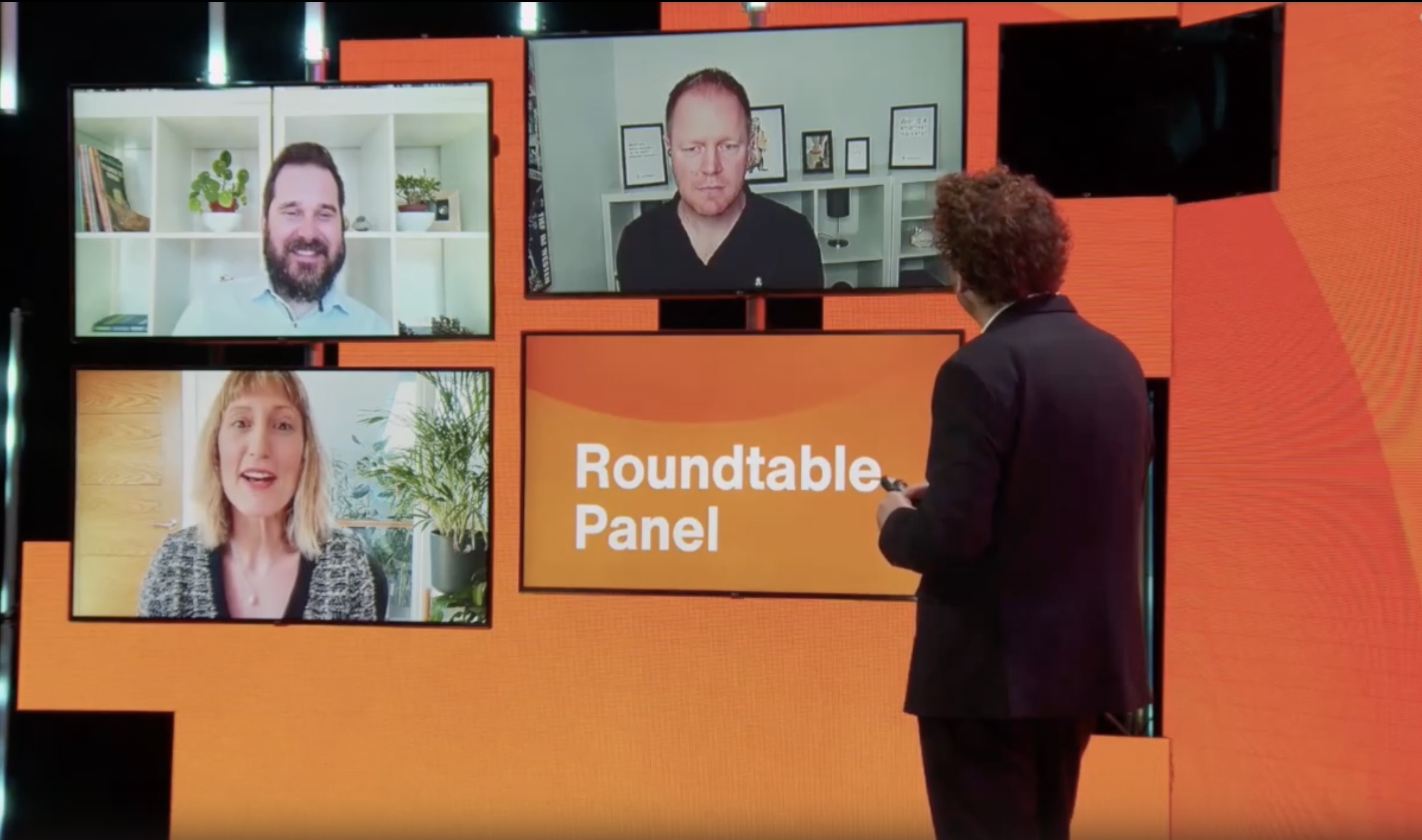

Too good to be true? Building a strategy that delivers content at higher quality, in greater volume, and faster
Victor Lebon, ICP’s Chief Innovation & Strategy Officer ran round table sessions with a group of Chief Marketing Officers and other senior leaders at the recent European GDS Digital Summit.
The start point was this:
A Picture Lasts Forever: Unlocking the Long Term Value (LTV) of your Marketing Assets
What happens when we treat our marketing assets as true investments, with lifetime value and ROI. This is, after all, the brand art that presents us to the world. We dream it up, create it, put it everywhere all at once, and then…on to the next campaign? Have we planned to get the most out of our content, as growth engines, relationship builders and brand drivers? Have we really unlocked its long-term power?

The first session was used to brainstorm the challenges experienced by senior marketers as they continue to feed the hungry content monster. Its appetite is driven by the combined forces of multiple digital channels and from the heightened expectations from customers for a great experience. Together these conspire to put tremendous pressure on the quality, quantity and speed of content publication.
After much debate, Victor summarised as follows the challenges being faced:
- How to strike the perfect balance between innovation in content & content-reuse
- How to strike the right balance in content creation between performance marketing (pandemic-forced, short-term, drive the next click, immediate ROI) vs. brand-building (long term, consistency of messaging, considerations across culture, language and geography)
- How to brief for both (platform & execution)
- How to evaluate payback of short-term content vs. long-term content, recognising their different roles and accepting attribution measurement complexity
- How to make content reuse ‘feel right’, making it rewarding and worthy of celebration. This was summarised by one contributor as ‘recognising the knowledge gap vs. comfort gap dilemma'. The driver here is that marketers are conditioned to think about new content is always the solution to a strategic question, and that conditioning is very deep-rooted.
This summary was accepted by the group, and then Victor led the discussion around solutions that can help ease the challenges.
The first option is to be intentional about defining the balance between the short and longer-term nature of marketing in your environment. The risk is a pendulum swing alternating between both solutions, destined to be in a state of constant flux and doubt. Decide what matters in your context, own your strategy. That’s the driver for then building a clear content and comms plan that balances competing priorities in the perfect way to match your circumstances.
This permits decisions to be made about when the value of new creative can outweigh the advantages of content reuse. But even more importantly, the new content that you do create is being purposefully created for a lifetime of easier reuse and adaptation.
As a separate conversation and inspired by a wonderful presentation about the benefits and challenges of using TikTok, the group discussed content strategy in that context. We discussed how most social channels, like Facebook and Instagram, are actually similar in makeup to their marketing ancestors of print and TV. Relatively well crafted, finished artworks are designed to engage with an audience. TikTok, on the other hand, has a very different style; social channel on steroids, that dares brands to open up and share their work in progress. This was an interesting debate with a surprising conclusion. TikTok does not reward highly curated work - it feels out of place. It values spontaneity, incompleteness, it dares brands to be authentic, even reveal some vulnerability. The guidance from the group was to know your brand equity and be aligned, then be brave and get into the spirit! Watchouts were numerous with some brands that dive straight in as if it’s simply ‘another’ channel, and score a big fail for repurposing material designed for the more traditional media channels. As our speaker from Zalando described, your last good work will only fail in the sense of getting fewer views. You’re unlikely to cause yourself big problems so long as you are staying aligned with your values.
Solutions also need to take account of your marketing personalisation strategy and its requirement for data. Again, this is an area for which there is no generic solution. Financial services can aspire to, and build, a customer experience environment that reflects the unique characteristics of its customer base. Selling semi-commoditised services like paper towels for kitchen use requires a very different direction. Both data and personalisation can still drive a strategy that reflects your marketing goals, even though the end result is destined to sell the same standard 4 pack of kitchen towels rather than an infinitely configurable range of financial services products. This thought process then lets you make decisions around the detail of content strategy to support a choice around new versus re-use.
On the last conference day, Victor summarised much of the roundtable debate in a lively interview session in front of the whole audience.
A noteworthy addition to the debate came from a delegate statement stressing the positive sustainability impact of putting marketing content reuse front and centre of strategy. Budget reductions have been the traditional goal of companies as they seek a lower unit cost per creative item. And our world is full of stories of assets being duplicated around the world as people in one territory cannot find the right video showing the carbonated glass drinks bottle being held in the hand with backlit condensation and the rapid escape of gas as the cap is removed before thirst is quenched. Cost has always been a driver, but now it has its double whammy partner with sustainability. Think of the carbon waste as each shoot takes place to repeat that video on on a beach in every region, or even each country, every few years.
The second addition to the debate on the final day was NFTs – what might their impact be on brands and their content strategies. That’s the subject of a future blog, but in the context of sustainability, Victor noted the very clear differentiation between NFT (token) and NFO (object). The token requires the carbon-hungry blockchain, but the object in itself does not have to have the same scale of impact.
Coming out of this discussion we heard some wonderful feedback about how refreshing it can be to look at content through this lens of ‘new versus re-use’. It’s a concept that speaks to what brands need now, following a long period dominated by the safe option of always buying ‘new’.
The driver has always been there to consider creative asset lifetime value and its suitability for re-use and future inspiration. But only now is this discussion really coming to the fore.
Look out for several exciting new services from ICP which address these points. We call our solution DAM Driven Production™. Please ask us if you'd like to know more.
David Howlett, Marketing Director

.png?length=800&name=Untitled-4-CrOps%20Maturity%20Assessment%20landing%20page%20graphic%20(1).png)


%E2%80%8B-%E2%80%8B%20%E2%80%8B.png?length=256&name=Purple%20B__Align%20(Content%20Alignment)%E2%80%8B-%E2%80%8B%20%E2%80%8B.png)
%E2%80%8B-%E2%80%8B%20%E2%80%8B-1.png?length=256&name=__Align%20(Content%20Alignment)%E2%80%8B-%E2%80%8B%20%E2%80%8B-1.png)
%E2%80%8B%20%E2%80%8B.png?length=256&name=Blue%20B__Implement-%20(Technology%20Implementation)%E2%80%8B%20%E2%80%8B.png)
%E2%80%8B%20%E2%80%8B.png?length=256&name=__Implement-%20(Technology%20Implementation)%E2%80%8B%20%E2%80%8B.png)
%E2%80%8B.png?length=256&name=Blue%20B__Adopt-%20(Technology%20Adoption)%E2%80%8B.png)
%E2%80%8B.png?length=256&name=__Adopt-%20(Technology%20Adoption)%E2%80%8B.png)





%E2%80%8B-%E2%80%8B%20%E2%80%8B.png?length=256&name=__Align%20(Content%20Alignment)%E2%80%8B-%E2%80%8B%20%E2%80%8B.png)





%E2%80%8B-%E2%80%8B%20%E2%80%8B.png?length=256&name=Blue%20B__Align%20(Content%20Alignment)%E2%80%8B-%E2%80%8B%20%E2%80%8B.png)
%E2%80%8B%20%E2%80%8B.png?length=256&name=Cyan%20B__Implement-%20(Technology%20Implementation)%E2%80%8B%20%E2%80%8B.png)
.png?length=256&name=Blue%20B__Activate%20(Content%20Activation).png)
.png?length=256&name=__Activate%20(Content%20Activation).png)

.png?length=256&name=Data_%20Outcome_White%20BG%20(1).png)










